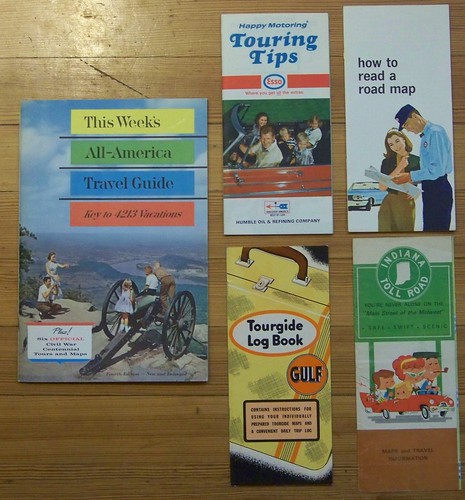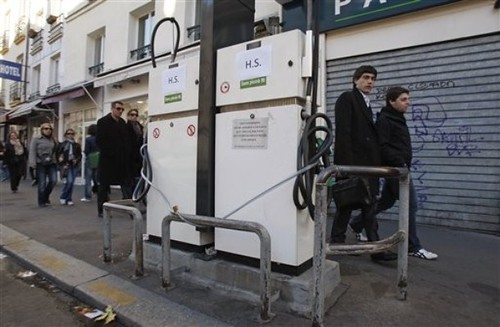100th anniversary of the first gasoline station this Sunday
According to the National Association of Convenience Stores ("The Modern Gas Station Celebrates 100th Anniversary"), Sunday December 1st marks the 100th anniversary of the first gasoline station, which was created by Gulf Oil Company and opened in Pittsburgh in 1913 (pictured left, source, Gulf Oil).
I think the history of gasoline marketing is very interesting in how it was key to the take up of automobility and changing people's perception of how to get around, the development of the travel industry, and the creation of a single integrated consumer market in the US.
-- Gulf Oil History Page and Timeline of key developments in the industry
It is also incredibly instructive in demonstrating that a complete system of complementary services needs to be provided to support sustainable mobility (biking and transit) and a car light lifestyle. Without a comparable system of services, biking, transit and non-car dependent mobility is impractical for many and certainly inefficient.
From the NACS press release:
As people began traveling outside of their immediate area--recreationally first, and then for tourism--an infrastructure had to be created to support them on their trip.
- There are 152,995 retail fueling sites in the United States. This is a steep and steady decline since 1994, when the station count topped 202,800 sites. This count includes 123,289 convenience stores selling fuel, plus grocery stores, truck stops, traditional gas stations and low-volume fueling locations like marinas. (Source: National Petroleum News’ MarketFacts; NACS/Nielsen Convenience Industry Store Count)
- The average convenience store sells roughly 128,000 gallons of motor fuels per month, or approximately 4,000 gallons per day. (Source: NACS State of the Industry 2012 data)
- While about half of the convenience stores selling gasoline are “branded” outlets that sell a specific refiner’s brand of fuel, less than 0.4% are owned by the major oil companies. Chevron Corp. (406 stores), Shell Oil Products US (23 stores), and ConocoPhillips Inc. (1 store) still own and operate retail locations; ExxonMobil Corp. and BP North America do not own any locations. (Source: Nielsen data)
- The retail gross margin (or markup) on gasoline in 2012 was 18.4 cents/gallon, or 5.1% of the price of gas. Over the past five years, gross margins averaged 16.9 cents per gallon. (Source: Oil Price Information Service)
This infrastructure included roads obviously which is deserving of a separate entry, but also gas stations and repair garages, parking structures and lots, and on the road bigger "service stations" especially with clean restrooms, restaurants--think Howard Johnsons and other chains that developed like Bob's Big Boy, and motels, first independently owned properties, later organized into franchised units like Best Western or Holiday Inns.
This was complemented by travel services--most gas companies had such operations but there was also the American Automobile Association--to help you organize your trip, maps and other promotional and informational products and brochures.
In the gasoline, restaurant, and lodging categories, the respective sectors have continued to evolve and reorganize over time, from independent companies to large chains or branding systems.
 Map products evolved too. Initially, many of the companies promoted travel and local landmarks and historic sites that could be visited while en route by depicting them on maps. Gulf and Esso were especially known for this. And map covers were designed to highlight local historic sites. Later many of the maps become strictly informational, depicting roads and routes, and rather than depict scenes of local significance on the cover of the map, the company instead promoted itself.
Map products evolved too. Initially, many of the companies promoted travel and local landmarks and historic sites that could be visited while en route by depicting them on maps. Gulf and Esso were especially known for this. And map covers were designed to highlight local historic sites. Later many of the maps become strictly informational, depicting roads and routes, and rather than depict scenes of local significance on the cover of the map, the company instead promoted itself.This shows how as automobility became the paradigm, gasoline became a commodity and the need to have a relationship with "your" gas company was no longer necessary. Companies don't spend much energy or money on marketing anymore. Plus the margin of profit on the sales of gasoline is so small that stores find they make more money selling other products, that gasoline is the draw but the profit comes in add on sales. And most gasoline stations no longer are connected to auto repair operations, although here and there exceptions remain.
Today, convenience store chains have picked up the relationship that has been discarded by the gasoline refining brands.
There are a couple of good books on the subject including The Gas Station in America by Jakle and Sculle and a book on road maps that I can't seem to locate at the moment.
The gas station raises important urban questions
1. The insertion of gasoline stations into pre-existing urban fabric helped to spark the modern historic preservation movement, starting in Charleston, South Carolina, which organized in part out of a response to service stations coming into neighborhoods by buying and tearing down residential properties.
Although separately, gasoline stations then became an element of architectural history in its own right.
2. Initially, gasoline stations could provide curb-side service. Pumps were on the curb and cars drove up and were serviced while still on the roadway. For fire safety reasons, cities banned this method, and stations moved to the lot form. The lot form made it harder to sensitively integrate gasoline stations into the pre-existing built environment.
It's still legal in Paris. (AP Photo/Michel Euler, 10/25/2010.)

3. Gasoline stations can contribute to and abet urban problems, especially crime. One of my old rules about safety in the city was to "not buy gas at night in the city." Gas stations can be gnarly places in terms of panhandling, robbery, theft, loitering, etc.
And, as discussed in this blog entry, "360 Apartment building + Giant Supermarket vs. a BP gas station," about the H Street NE neighborhood, a proposal by BP to create a massive station in the neighborhood touched off a resident movement that has culminated in a wide-ranging neighborhood revitalization program. On the other hand, later administrations weren't interested in standing up to gas station proposals elsewhere in the corridor and the city.
4. As alluded to in the previous point, gas stations also become opportunities for redevelopment. As demand for well-located properties increase in high demand locations, gas stations get torn down and replaced by more profitable development, although sometimes gas service may remain on part of the site.
5. In response, in 2009, a DC City Councilman was concerned about the decline in the number of gas stations in the city and wanted to give them tax breaks. See "Where did all the gas stations go?" from the Washington Post.
Image of the Parker's Market Urban Gourmet location on Drayton Avenue in Savannah, Georgia. Image from the Savannah Morning News.
6. While other DC Councilmembers and the Executive Branch think gas prices are too high. See "Joe Mamo, DC's Gas-Station Master" and "Attorney General Sues Gas King Joe Mamo" from the Washington City Paper.
7. As gasoline stations become convenience stores they can become great corner stores. But it doesn't happen very often.
In the Savannah Historic District, the Parker's Convenience Store chain runs two stores that they call "Urban Gourmet Markets," significantly upgrading the quality of the "convenience store" food and beverage offering. As a bonus, the store on Drayton Avenue maintains the old style gas station architecture (it has to, it's a historic district). Many other convenience store companies are augmenting their food operations, although not so much for urban locations.
8. In the DC area, some gasoline stations have taken this in a different direction, becoming places for high quality quick service food. See "Fast Gourmet fills 'em up" from the Washington Post.
9. And the impact of Superstorm Sandy on gasoline supplies in impacted areas of New York and New Jersey showed the problems of gasoline dependence. See "After Sandy, New York will hold strategic gasoline reserves" from the Washington Post and "After Sandy, gas lines stretch for miles" from CNN.
Labels: car culture and automobility, change-innovation-transformation, gasoline, transportation planning






1 Comments:
Nice information. Thanks for sharing the article in the blog.
thank you
Post a Comment
<< Home